Gum Graft
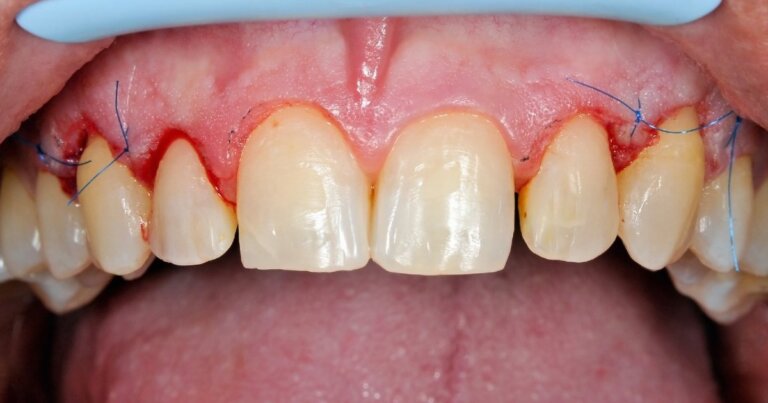
What Is A Gum Graft?
Gum Grafting is a dental procedure used to treat gum recession, a condition where gums pull back from the teeth, exposing the roots and increasing the risk of sensitivity, decay, and further gum deterioration.
In this procedure, grafting tissue is added to the receded area. The tissue can be harvested from the patient’s palate or from a tissue bank, and it helps to cover the exposed roots, reinforcing the gumline and protecting teeth. Gum grafting is not only about appearance but also about protecting your teeth and reducing tooth sensitivity.
If you’re in Toronto and considering a gum graft, Atlas Dental offers state-of-the-art options, including minimally invasive techniques. Before you deciding on whether a Gum Graft are right for you, there are some things you should know:
- Who Needs A Gum Graft?
- Advantages Of A Gum Graft
- The Different Types Of A Gum Graft
- How Much Does A Gum Graft Cost?
- Steps In The Gum Graft Procedure
- Frequently Asked Questions About Gum Grafts
If you have any further questions about A Gum Graft or other dental services offered at Atlas Dental, please contact us.

Free phone consultation
Have questions about improving the health of your gums and repairing your receding smile? Schedule a free phone consultation with our Toronto dentist.

5 star google reviews
See for yourself why more and more people are choosing Atlas Dental for a healthy smile using minimally invasive tunnel gum grafts.

Book In-Person Consultation
Want to know if you are a candidate for gum grafting for a healthier smile? Book an in-person consultation online ($50 exam fee)
Who Needs A Gum Graft?
A gum graft is recommended for individuals with moderate to severe gum recession. Common reasons for gum recession include:
- Periodontal Disease: Advanced gum disease can destroy the gums and bone supporting teeth.
- Aggressive Brushing: Using a hard-bristled brush or excessive force while brushing can wear down gum tissue.
- Genetic Predisposition: A family history of gum recession may increase the likelihood of needing a gum graft.
- Hormonal Changes: Pregnancy and menopause can lead to gum recession.
- Orthodontic Treatment: Braces and other orthodontic appliances can sometimes cause gums to recede.
- Injury or Trauma: Impact to the mouth or specific teeth can lead to gum recession.
It is important to consult with a dental professional to determine if you are a candidate for a gum graft. They will assess your oral health, evaluate the extent of gum recession, and recommend the most suitable treatment plan tailored to your specific needs. If you have further questions about a Gum Graft, please contact us.
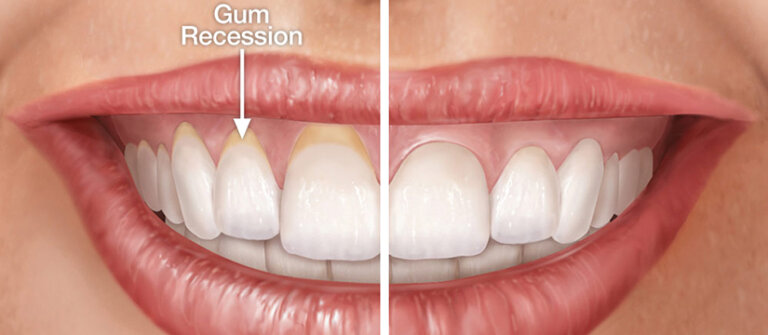
Advantages Of A Gum Graft
A gum graft provides several long-term benefits that go beyond aesthetics:
- Restores Gumline: Covers exposed roots and restores a balanced gumline, enhancing smile aesthetics.
- Protects Tooth Roots: Shields roots from decay, abrasion, and temperature sensitivity.
- Prevents Further Recession: By reinforcing gums, the graft slows or stops the progression of gum recession.
- Improves Oral Health: Healthier gums make it easier to maintain good oral hygiene and reduce bacteria buildup.
- Preserves Bone and Supporting Structures: Reduces the risk of bone loss around teeth, which is crucial for long-term oral health.
- Boosts Self-Confidence: A restored, healthy smile enhances self-esteem and comfort.
It is essential to consult with a qualified dental professional to assess your specific situation and discuss the advantages of gum grafting in your particular case. They will explain the benefits in further detail, address any concerns or questions you may have, and guide you through the entire treatment process. If you have further questions about the benefits of a Gum Graft, please contact us.
The Different Types Of Gum Graft
There are several types of gum grafts, each suited for specific cases. At Atlas Dental, we offer different options, including:
Minimally Invasive Tunnel Graft
Uses tissue bank grafts and involves minimal incisions. This technique is less invasive, comfortable, and highly effective for many cases.
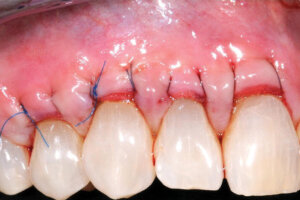
Free Gingival Graft
Harvests a thick layer of tissue from the palate and applies it directly to the receded area, providing additional gum thickness.
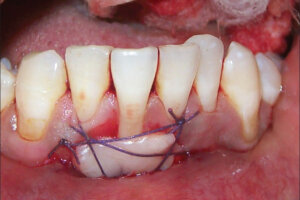
Connective Tissue Graft
Accesses the connective tissue underneath the palate surface. This graft is ideal for covering exposed roots and adding volume to receded gums.
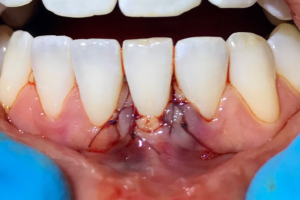
Lateral Pedicle Flap Graft
Uses gum tissue from a nearby area, retaining its blood supply, making it suitable when there’s adequate tissue adjacent to the affected area.
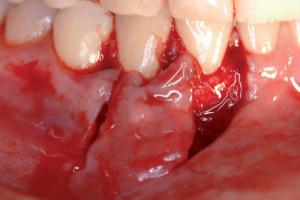
The choice of gum grafting technique depends on various factors, including the extent of gum recession, the condition of the surrounding tissues, and the desired outcome. Your periodontist or dental professional will thoroughly evaluate your situation and recommend the most appropriate type of gum graft for your specific needs. If you have further questions about the different types of Gum Graft, please contact us.
Cost of Gum Graft
Gum Grafts cost $1850 per tooth site using a minimally invasive soft tissue grafting technique. The codes relevant to gum grafting in the Ontario Dental Association’s Suggested Fee Guide appear as follows:
- 42552 – Allograft, for root coverage – per site: $1600 + Dental Material Expense ($250)
- 42557 – Allograft, adjacent to an implant – Per site: $1600 + Dental Material Expense ($250)
Gum Grafts are sometimes considered a supplementary service by dental insurance plans and may or may not be covered by your dental insurance. Be sure to find out from your dental insurance plan provider how much you are eligible for before going ahead with dental treatment. Your dentist can help you submit an predetermination to your dental insurance.
For patients without dental insurance, Atlas Dental is pleased to offer dental financing through iFinance Dentalcard. Affordable payment plans start at 7.95% for terms of 6 months to 6 years. To learn more about Dentalcard dental treatment financing, follow this link.
Steps In The Gum Graft Procedure
The gum graft procedure is typically performed by a periodontist or a specialized dental professional who has expertise in gum tissue regeneration and oral surgery. Here’s an overview of the typical steps involved in a gum graft procedure:
- Consultation: A thorough evaluation will determine the best grafting technique for your needs.
- Anesthesia and Preparation: Local anesthesia ensures comfort, and the graft area is prepared for the procedure.
- Graft Harvesting: If needed, tissue is harvested from the palate or a tissue bank.
- Graft Placement: The graft is placed over the receded area and secured with sutures.
- Post-Procedure Care: Detailed aftercare instructions will be provided to ensure optimal healing and success.
- Follow-up: Regular check-ups will monitor healing and address any concerns.
Your dental professional will guide you through the entire process, explain the details of your procedure, and address any concerns you may have. If you have further questions about the Gum Grafting procedure, please contact us.
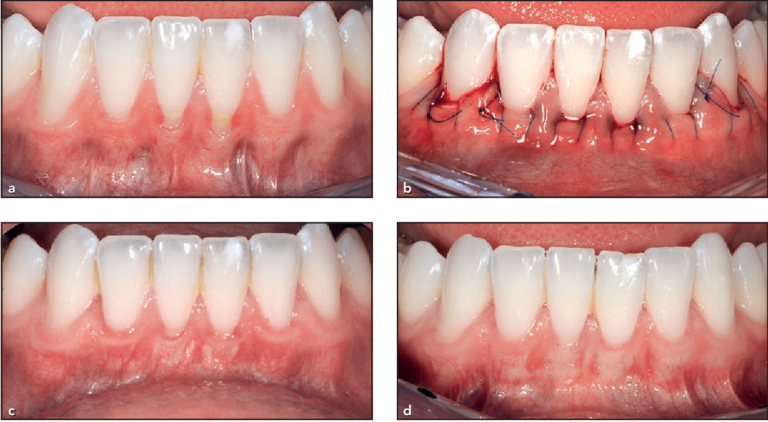
Frequently Asked Questions About Gum Grafts
- How Long Does a Gum Graft Last?
A well-cared-for gum graft can last many years. Good oral hygiene, managing underlying causes of recession, and regular dental visits are crucial for prolonging the success of the graft.
- How painful is the gum grafting procedure?
Patients typically experience minimal discomfort during the procedure due to local anesthesia. Post-operative discomfort varies but can usually be managed with prescribed pain relievers and proper aftercare.
- What is the recovery time after a gum graft?
Initial healing usually occurs within two weeks, but complete healing can take a month or more. During this time, it’s important to follow your dentist’s aftercare instructions to ensure proper healing.
- Will insurance cover the cost of a gum graft?
Coverage depends on your insurance plan and the reason for the procedure. If the graft is deemed medically necessary, insurance may cover a portion of the cost. It’s advisable to check with your insurance provider for specific details.
- What Are Common Complications?
Most gum graft procedures are successful with minimal complications, but potential risks include infection, bleeding, and graft rejection. Following gum graft aftercare guidelines reduces these risks significantly.
While a gum graft is intended to be a long-lasting solution for gum recession, individual results may vary. It is important to consult with your dental professional to assess your specific case. If you have further questions about the longevity of a Gum Graft, please contact us.

